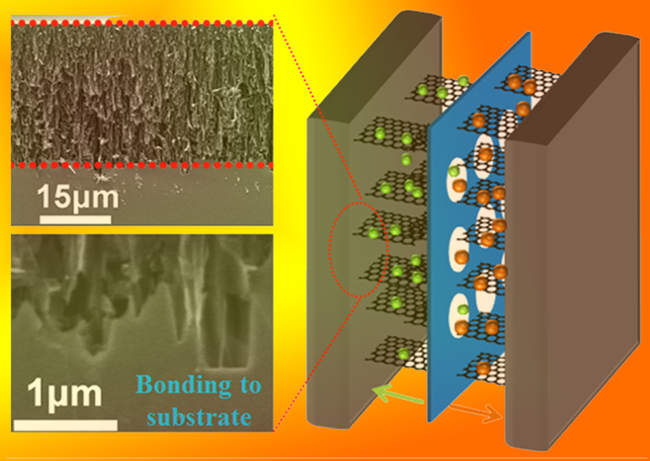
The ever-increasing demand of multifunctional integrated circuitry has spawned enthusiastic quest for efficient, miniaturized, compact energy storage devices. Micro-supercapacitors (MSCs) with appealing characteristics of high power density, fast charge and discharge rate, and long lifetime are gradually acknowledged as a discrete microscale power source for directly integrating microelectronic systems on chip. Until now, tremendous efforts have been devoted to developing electric double layer capacitive nanocarbons for high-power MSCs with long cyclability and fast frequency response.
However, the complex porous structure of most nanocarbon electrodes and strong restacking of graphene nanosheets negatively impacts high-power handling characteristics of MSCs because of the long path of ion diffusion. To realize high-power MSCs, designing a shape-engineered electrode with short channel lengths and easy accessibility of electrolyte ions as well as strong interfacial interaction between electrode and current collector is an important and necessitating requirement.

High-density VG arrays for direct integration of high-power supercapacitors (Image by ZHENG Shuanghao and ZHAO Xuejun)
To address this, scientists WU Zhongshuai and BAO Xinhe et al at Dalian Institute of Chemical Physics, collaborated with GUO Liwei et al from Institute of Physics of CAS, developed the unidirectional arrays of high-density vertically aligned graphene (VG), derived from thermally decomposed SiC substrate, for high-power MSCs. This work has been published online in ACS Nano. (DOI: 10.1021/acsnano.7b00553).
The construction of high-power MSCs was based on high-density unidirectional VG arrays directly derived from thermally decomposed SiC substrate. The resulting VG arrays presented high-density structurally ordering alignment of monolayer and few-layer graphene nanosheets, edge-enriched structure, open intersheet channels, high electrical conductivity, and strong bonding of the VG edges to the SiC substrate. The fabricated VG-MSCs displayed high areal capacitance and volumetric capacitance, fast frequency response (9 ms) and excellent long-term cyclability.
Remarkably, VG-MSCs operated in both gel electrolyte and ionic liquid can operate well at a high scan rate of up to 200 V s-1, and showed high power density of ~61 W cm-3. Therefore, the SiC substrate is promising for large-scale production of high-density VG arrays with strong bonding to the conductive substrate, and subsequently for their direct integration of high-power super-capacitors. (Text and Image by ZHENG Shuanghao and ZHAO Xuejun)
Funder: National Natural Science Foundation of China, Ministry of Science and Technology of China, Natural Science Foundation of Liaoning Province, Thousand Youth Talents Plan of China, DICP, China Postdoctoral Science Foundation and dedicated funds for methanol conversion from DICP.

86-10-68597521 (day)
86-10-68597289 (night)

52 Sanlihe Rd., Xicheng District,
Beijing, China (100864)

